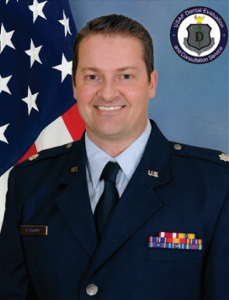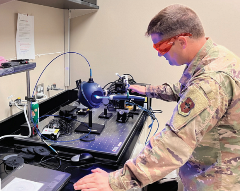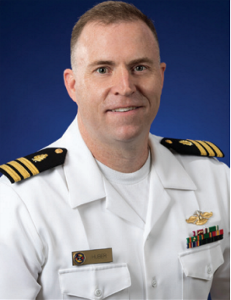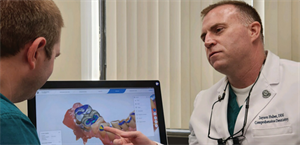‘My Workday Is Not What You Would Think’: Options Abound for Military Dentists
To many, the thought of military dentistry evokes images of dentists treating urgent oral healthcare problems on the battlefield. This is only a small part of the job description — an entire world of dentistry exists within the federal services. Military dentists conduct cutting-edge research, utilize best-in-class technology and participate in world-renowned education programs. They maintain the oral health of today’s service members while helping create the dentists and dentistry of tomorrow. Below, four dentists in various branches of the armed services share their stories and their daily responsibilities.
Lt. Cmdr. Kathleen Chiodo, DDS, FAGD, U.S. Navy
As a fourth-generation Naval officer, I graduated from Marquette University School of Dentistry on a Navy Health Professions Scholarship Program (HPSP) scholarship in May 2013. After graduation, I reported to Naval Station Great Lakes in Illinois and completed a one-year advanced education in general dentistry (AEGD) residency. As the only boot camp for the Navy’s enlisted sailors, Great Lakes offers a unique opportunity to continue comprehensive post-dental school training, especially in restorative dentistry, endodontics and oral surgery. I deployed on the USS George H.W. Bush in 2014, arriving onboard via a Grumman C2-A Greyhound aircraft during Operation Inherent Resolve. With a team of four general dentists and one oral surgeon, over 6,000 sailors were kept mission-ready and prepared to fight. After completing my two-year assignment there, I reported to U.S. Naval Support Activity Naples in Italy, where I provided dental care in support of U.S. Naval Forces in Europe and Africa, which included over 30 different military commands, as well as military attaches throughout Europe and Africa. I then returned to Naval Station Great Lakes, where I spent three years training new dentists. As an AEGD assistant program director, I felt the call to teach and pursued the opportunity to attend Indiana University School of Dentistry’s Cariology and Operative Dentistry Program on a Navy scholarship.
Operative dentistry (called restorative dentistry at some dental institutions) is one of 14 postdoctoral training programs the Navy provides. This unique educational opportunity is for competitively selected dental officers to attend full-time out-service training at a civilian dental school. It is a three-year master’s degree that combines advanced clinical study, didactics and research, culminating in a defended thesis. This specialization provides the Navy with highly educated subject matter experts in preventive and restorative dentistry. The operative community’s mission is largely education focused. The Navy’s 26 active-duty operative dentists are assigned to Navy dental clinics, where the newest dentists, often fresh out of dental school, undertake their initial year of training. Operative dentists are AEGD and general practice residency (GPR) program directors; they are clinical mentors for new dentists completing orientation tours; they provide high-level evidence-based continuing education (CE) in the Navy and Department of Defense’s many CE courses; and they are the subject matter experts in restorative materials and equipment. Operative dentists are often seen as “force multipliers,” where their impact at large dental clinics provides clinical and didactic support to the dental fleet and prepares individual clinicians to be successful solo providers wherever they are deployed.
While away from the Navy dental clinics for these three years of training, I have not stopped advocating for dentists serving in the federal services. AGD’s Region 17 (made up of the federal services) recently set up a Continuing Education Committee to build upon our individual constituencies’ strengths and to share resources. Our mission is to provide meaningful CE opportunities to Region 17 members across the globe. The unique global geography of Region 17 creates opportunities to think outside the box for ways to reach our members. As chair of the Continuing Education Committee, I am bringing together dental leaders across the federal services to support quarterly AGD Region 17 webinars, support the Region 17-run AGD Fellowship Review Course and expand internal Region 17 educational resources. There are exciting things ahead for federal service members, and the Region 17 Continuing Education Committee is looking forward to continuing to serve.
 Lt. Col. Christopher J. Raimondi, DDS, U.S. Air Force
Lt. Col. Christopher J. Raimondi, DDS, U.S. Air Force
I am a board-certified general dentist, an educator and a dental research scientist. My education background includes completion of both U.S. Air Force (USAF) AEGD-1 and AEGD-2 residencies. Additionally, the USAF sent me to New York University to complete master’s-degree training in both dental materials and clinical research. I serve as an assistant director at the 59th Dental Group, Dental Research and Consultation Service. My current priorities are: (1.) Fulfill capability and knowledge gaps in today’s military dental practice; (2.) Provide responsive consultative service to the USAF, Army and Navy; (3.) Provide educational and research support to military dental specialty residents; and (4.) Collaborate with the American Dental Association (ADA) and the International Organization for Standardization on dental standards and other dental-related scientific issues.
I work at the U.S. Army Institute of Surgical Research, Fort Sam Houston, San Antonio, Texas. Our laboratory houses approximately $7 million of advanced testing equipment, highlighted by electron microscopes, nanome¬chanical testing equipment, an atomic force microscope, 3D polymer printers, several macro-scale mechanical testers, thermoanalysis machines, a Fourier-transform infrared spectrometer, a time-of-flight mass spectrometer, a micro-CT, a room dedicated as a standard dental lab and a room dedicated for studying light-related activities (e.g., curing lights). We conduct in-house experiments and support external tri-service research activities.
 An independent research project is required for all dental specialty residents to graduate. Annually, I mentor approximately 25–30 residents from all dental specialties by helping them formulate research ideas, write protocols, complete testing, analyze data and write their manuscripts. Several of these residents travel from other bases to conduct their experiments at our laboratory.
An independent research project is required for all dental specialty residents to graduate. Annually, I mentor approximately 25–30 residents from all dental specialties by helping them formulate research ideas, write protocols, complete testing, analyze data and write their manuscripts. Several of these residents travel from other bases to conduct their experiments at our laboratory.
Teaching is a significant aspect of my job. I am an assistant professor at the Uniformed Services University of the Health Sciences. I provide clinical supervision and lectures to residents at the comprehensive dentistry two-year AEGD program at Joint Base San Antonio. Additionally, I occasionally travel to other military bases to provide a lecture series on dental materials to one-year AEGD and GPR residents.
I am glad I made the choice to volunteer to be a USAF dental officer. I consider myself blessed to have been given so many unique opportunities for personal and professional growth. In my 13-year active-duty USAF career, I have served in the primary roles of clinician, educator and, now, researcher. A likely next step for me will be to lead as a commander. And, just as before, I will gladly accept that opportunity.
 Capt. Jayson H. Huber, DDS, MS, FAGD, U.S. Navy
Capt. Jayson H. Huber, DDS, MS, FAGD, U.S. Navy
I had been a practicing military dentist for eight years when I first decided to venture into the realm of dental education. After graduating dental school in 2006, I went directly into patient care treating Marines. I had done well in dental school, but, like most new dentists, I was humbled by how much there was still left to learn. With that experience, I applied and was accepted to a two-year training in comprehensive dentistry at the Naval Postgraduate Dental School (NPDS) in Bethesda, Maryland.
During this two-year AEGD program, I took didactic courses, got clinical mentoring for advanced procedures, completed a research project and earned a master’s degree. I knew I had grown as a dentist, but it wasn’t until the next three years of practicing that I realized just how blessed I had been to study under good mentors in dental school and at NPDS. Feeling a desire to give back, I stepped into the dental education arena.
Currently, I am the program director for 16 residents in the comprehensive dentistry program at NPDS. Teaching is tough, and every day brings new challenges. Surmounting those challenges and seeing the growth of these dental officers is incredibly fulfilling. Some of the challenges include research, creating new courses, scheduling seminars, teaching classes, updating curricula, staying current with the literature, preparing residents to challenge their boards and, my favorite, mentoring on the clinic floor. I truly enjoy sharing the tips and knowledge that I have gained from both my successes and failures.
In addition to the typical educator tasks previously described, military officers always have collateral duties. These are tasks that must be accomplished outside of your normal position description. Common duties include infection prevention officers, department heads and physical fitness leaders. I currently serve as a delegate to the ADA and specialty leader to a community of over 100 dentists.
Most nonmilitary dentists would probably be surprised to learn of the advanced technology in the military. Access to CAD/ CAM, 3D printing, microscopes, lasers and the latest materials allow us to deliver high-quality care to the military population.
 Though NPDS is a Navy establishment, we have long embraced the collaborative role of training residents from many federal agencies. Navy, Air Force, Army, Coast Guard and Veterans Affairs dentists have been trained within these halls. Though all the professors pass on knowledge to the residents, there are even more important roles that educators fill; possibly more vital to the profession of dentistry is showing dentists how to critically evaluate literature and new techniques being taught. We are also growing the next generation of leaders and educators by helping them gain the knowledge and communication skills necessary to teach others.
Though NPDS is a Navy establishment, we have long embraced the collaborative role of training residents from many federal agencies. Navy, Air Force, Army, Coast Guard and Veterans Affairs dentists have been trained within these halls. Though all the professors pass on knowledge to the residents, there are even more important roles that educators fill; possibly more vital to the profession of dentistry is showing dentists how to critically evaluate literature and new techniques being taught. We are also growing the next generation of leaders and educators by helping them gain the knowledge and communication skills necessary to teach others.
It’s hard to describe the pride I feel when I witness a dentist who was previously shy or lacking confidence go on to complete a challenging procedure or competently present a lecture to a group of 50 dentists from around the world. I have no fear about the future of dentistry because we have some amazing young professionals who will one day take our places.
The views expressed in this article reflect the results of research conducted by the author and do not necessarily reflect the official policy or position of the Department of the Navy, Department of Defense or the U.S. government.
Maj. Michael A. Kroll, DMD, MAGD, U.S. Army
My workday is not what you would think. Below is how I respond to the HPSP prospects who visit my Army dental clinic. Most dentists do not associate Army dentistry with digital scanners, esthetic restorations and 3D printing. Dental students I have met seem to have the perception that military dentistry is amalgams, extractions and rigid military doctrine. What I have found throughout my military career has been vastly different than most people’s expectations.
My Role in the Army
I am a comprehensive dentist in the U.S. Army. I attended dental school at Case Western Reserve School of Dental Medicine on a four-year HPSP scholarship and joined the active-duty Army in 2011. To become a 63B, the Army skill identifier for a “comprehensive dentist,” I completed an AEGD program at Fort Hood, Texas, and received my master’s degree in oral biology from the Uniformed Services University of the Health Sciences. Since graduation, I have deployed/traveled in support of training missions to three different continents, been a director of a 12-month AEGD program, deployed operationally in support of combat operations, completed military professional education in the form of Command and General Staff College, and have been able to maintain a full-time clinical practice. My passion in the field of dentistry has always been restoring the dentition, empowering the patient with the ability to be free of dental disease and making soldiers happy when they look at their teeth in the mirror. In my current role as digital dentistry consultant to the Army Dental Corps Chief, I strive to make this vision a reality for all of our soldiers, not just the ones who end up in my chair.
Our Vision for Army Dental Care
Army dental care has been at the forefront of transitioning to the future with digital dental capabilities. While it is imperative that we provide dental care in a managed care model under the auspices of a Ready Reliable Care framework, this has opened the door to delivering care tailored to our patients’ needs and desires. Ready Reliable Care focuses on a patient-centered, safe, efficient and continually improving process of care. The patient is always at the center of our decision-making process, and this has allowed us to invest in and develop a robust brain trust of digital dentistry in the Army Dental Care System.
I have leveraged digital technology to address three immediate needs of our population:
- Enhance the readiness of our population by reducing wait times.
- Increase quality of care by reducing steps that introduce inconsistency through human error.
- Standardize communication among specialists across the organization to enhance the safety of our patients.
My Practice in the Army
My daily practice in the Army revolves around complex restorative treatment planning. As a comprehensive dentist, I often get the dental cases that leave other general dentists scratching their heads, whether it is a complex restorative case involving anterior esthetics, a difficult caries control case in a high-anxiety patient or an after-hours dental trauma patient worried that they will never have the smile they had before their accident. I utilize state-of-the-art equipment like electric dental handpieces, LED overhead lights, digital radiographs, 3D cone beam computed tomography, intraoral scanners, 3D printers, digital design software and in-office milling of restorations. Restorative choice must be balanced with cost/time considerations and patient desires, but that doesn’t mean every patient gets an amalgam restoration. About 95%–98% of my dental practice consists of tooth-colored restorations. Modern concepts in dental restorations such as systematic approaches to deep caries removal, biomimetic principles, immediate dentin sealing, air abrasion and bonding of minimal retention preparations are cornerstones of my clinical practice. All of this is combined with tried-and-true methods of conventional gold indirect restorations and rubber dam isolation to help me practice within our Army Clinical Practice Guidelines.
The Army clinical practice is not all amalgams, extractions and glass ionomer. It is far from most preconceived notions and is truly a world-class environment in which to provide a level of patient care that most could not afford in the private sector. Taking care of those who serve our country is part of who we are as Americans, and it is the reason I am happy to put on the uniform every day and come to the greatest group dental practice in the world. We deserve to have great people protecting our country, and those who protect our country deserve to be proud of the smile they see in the mirror. I am just happy to be a part of that vision.
To comment on this article, email impact@agd.org.
